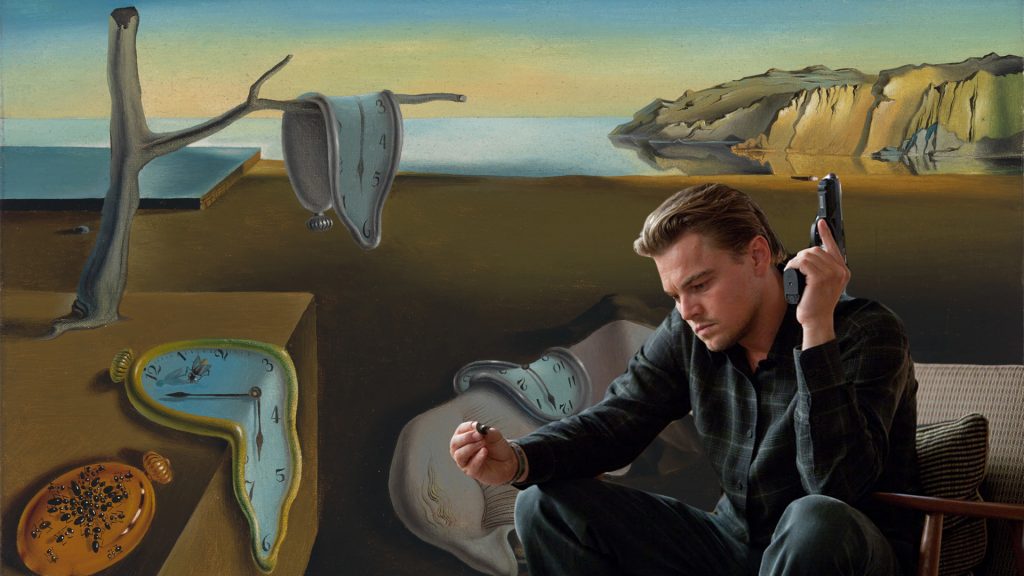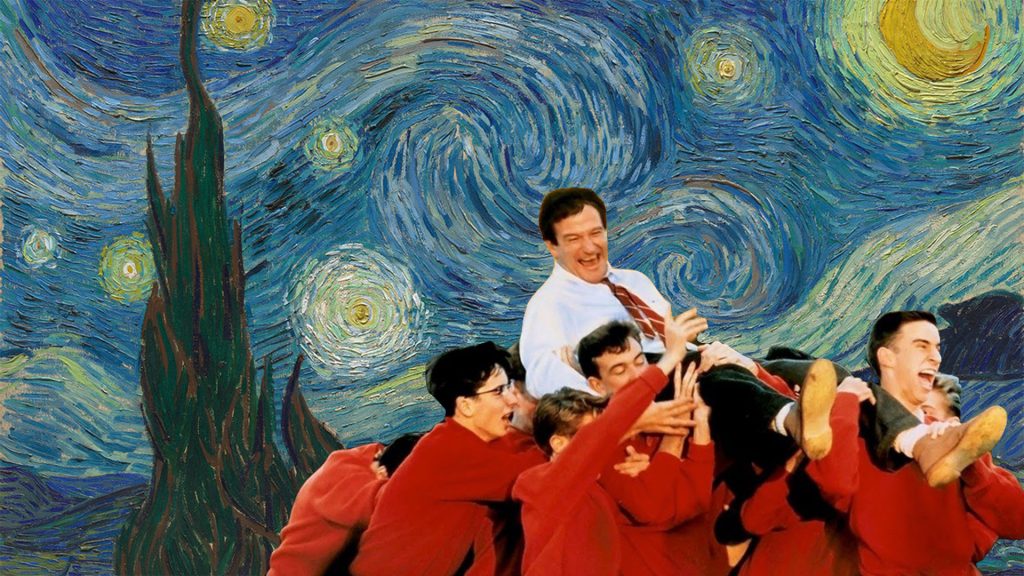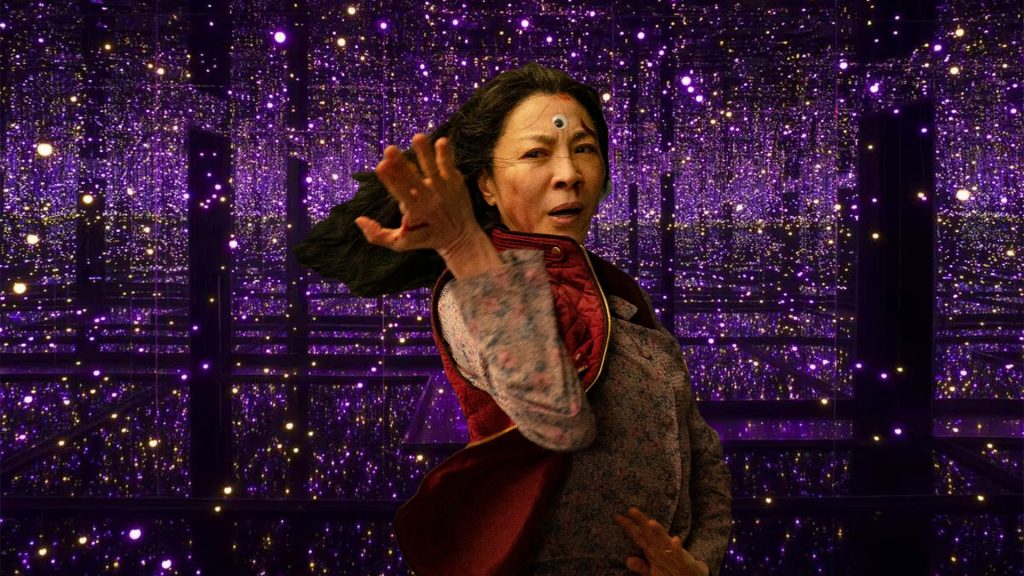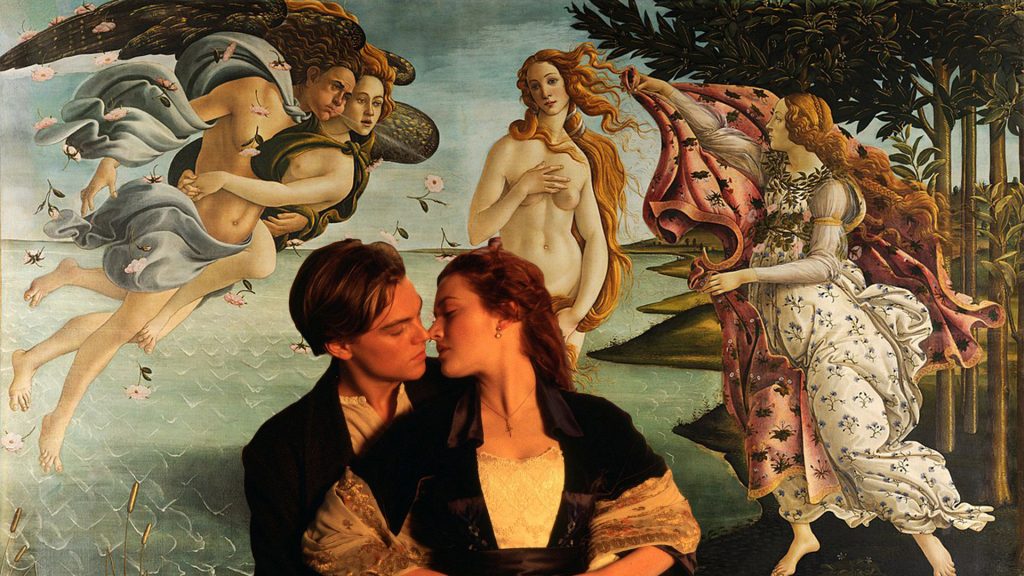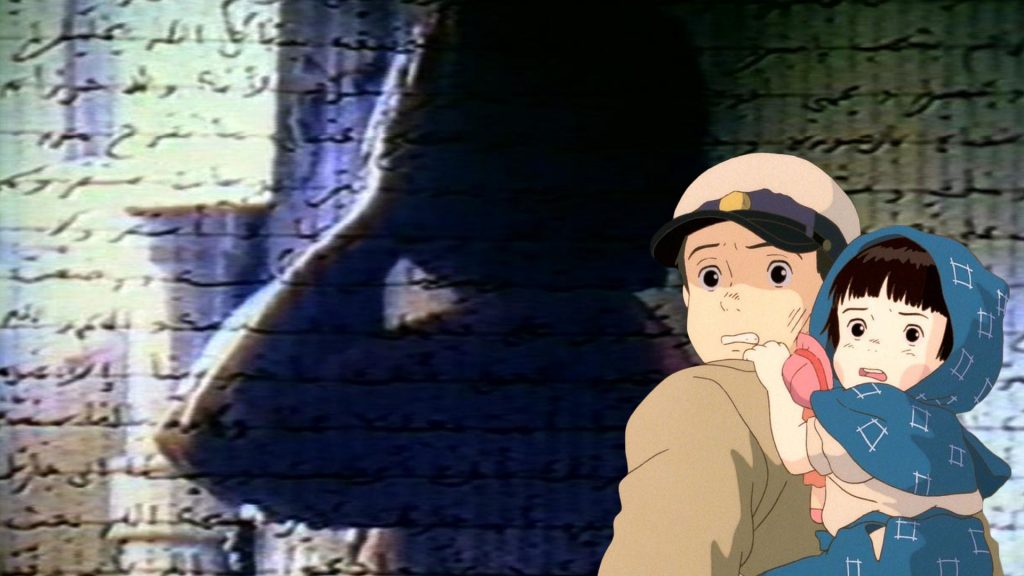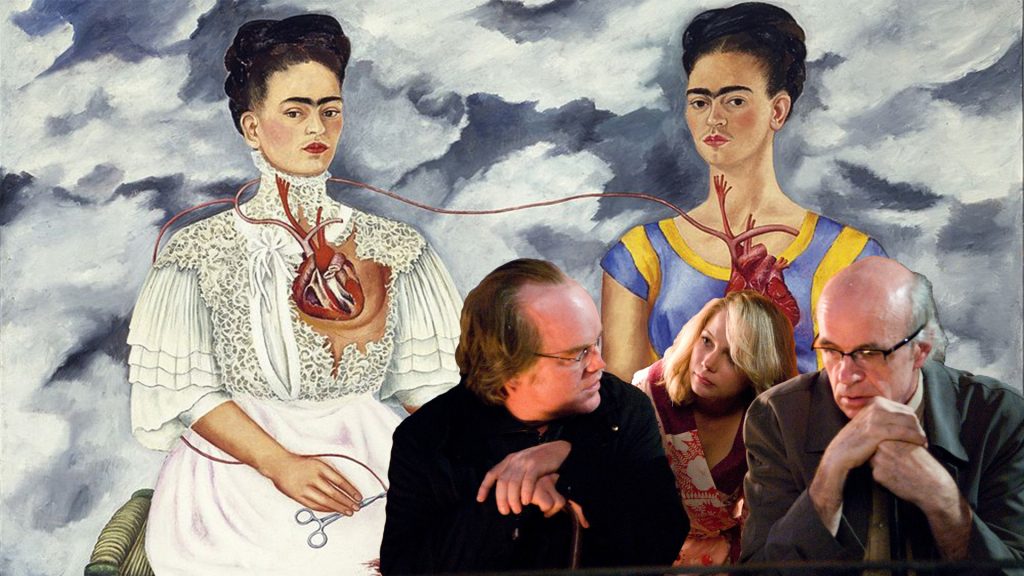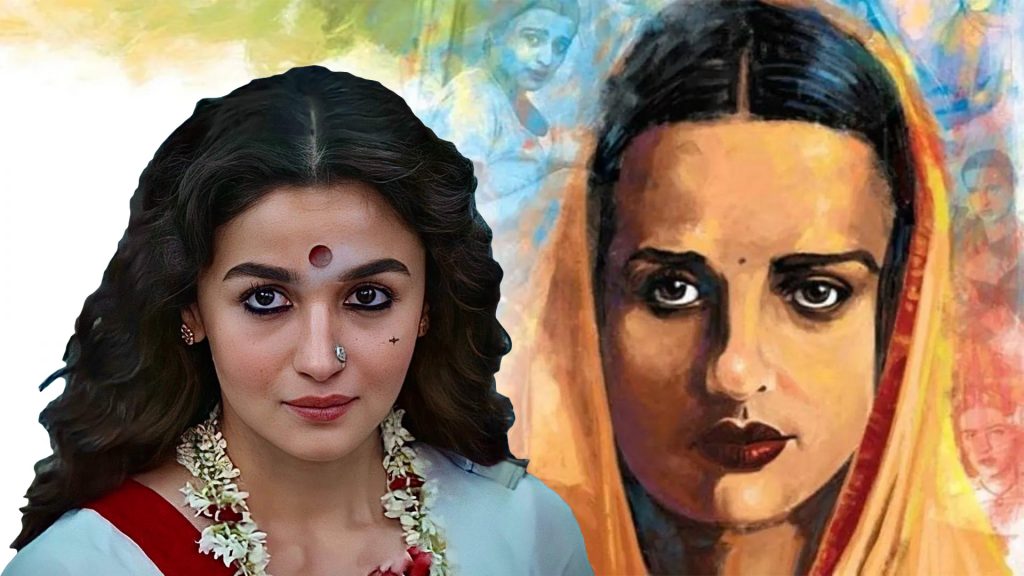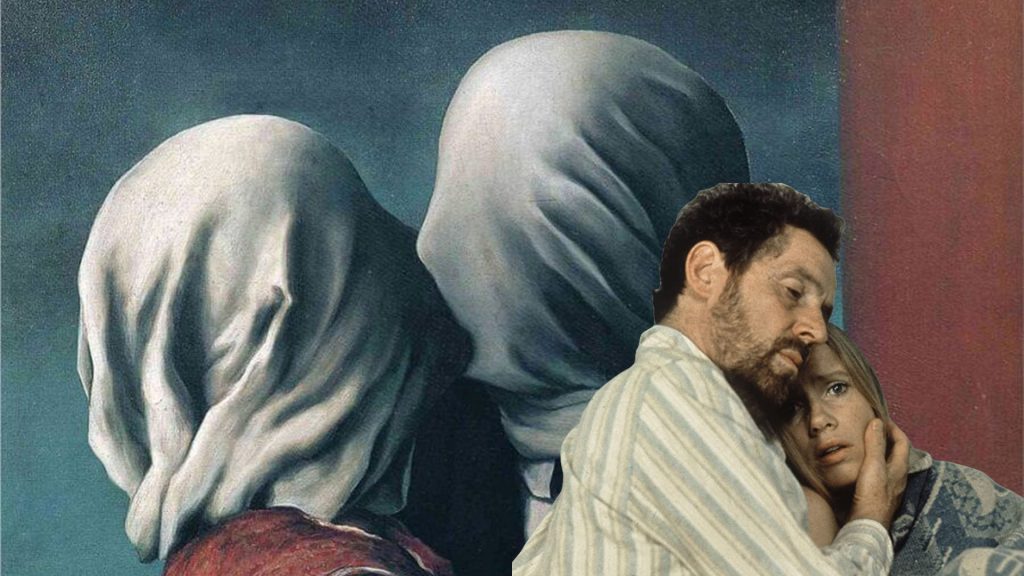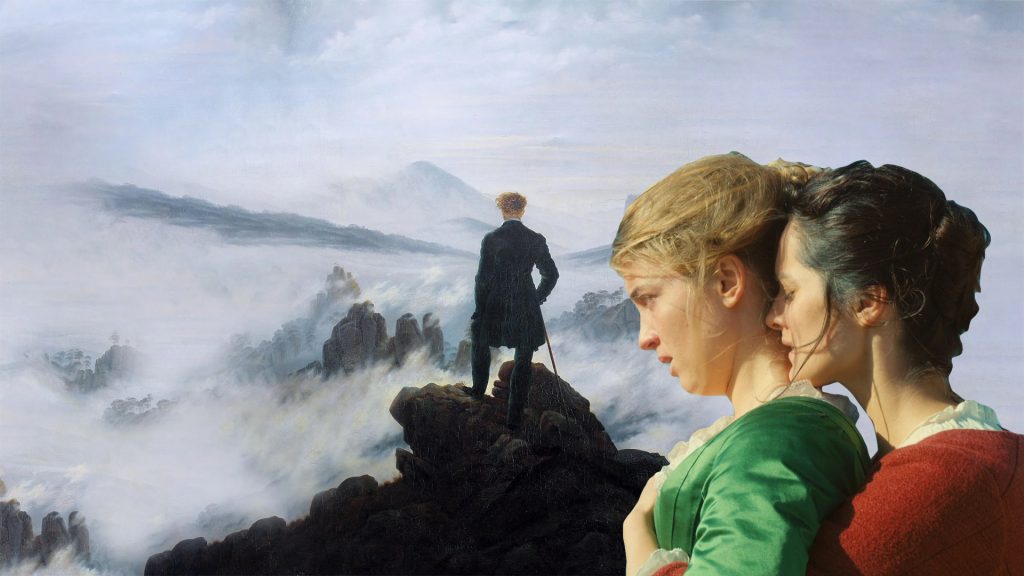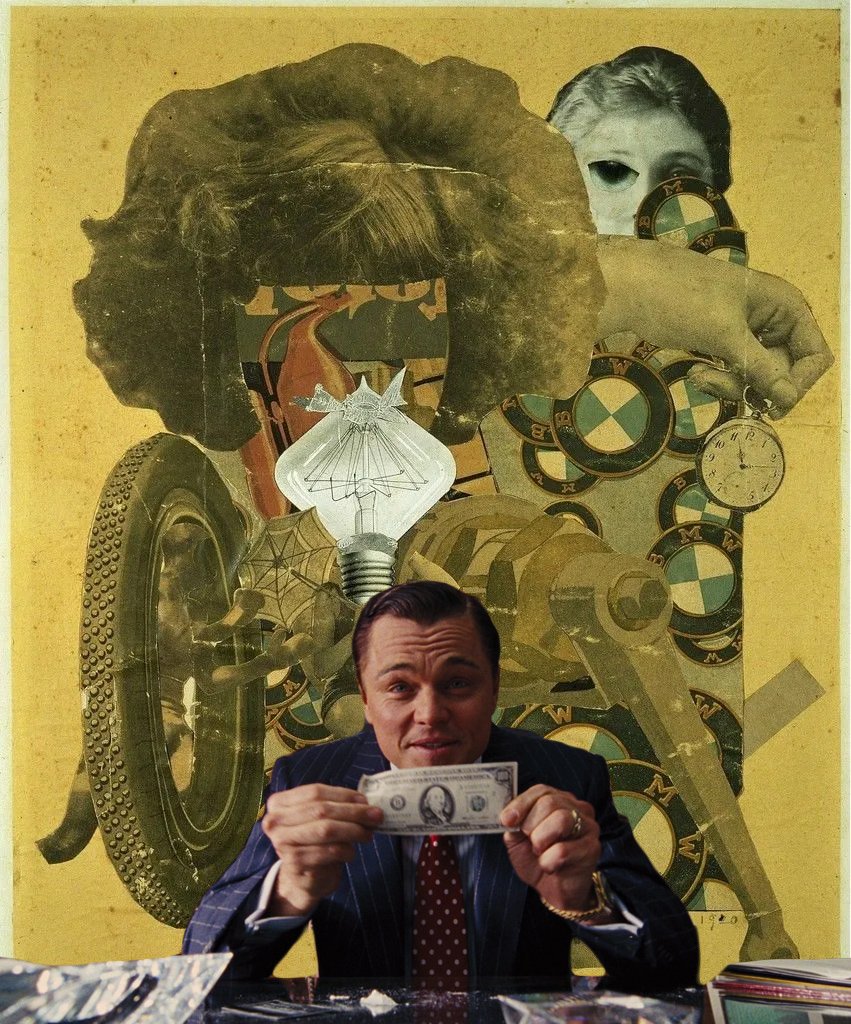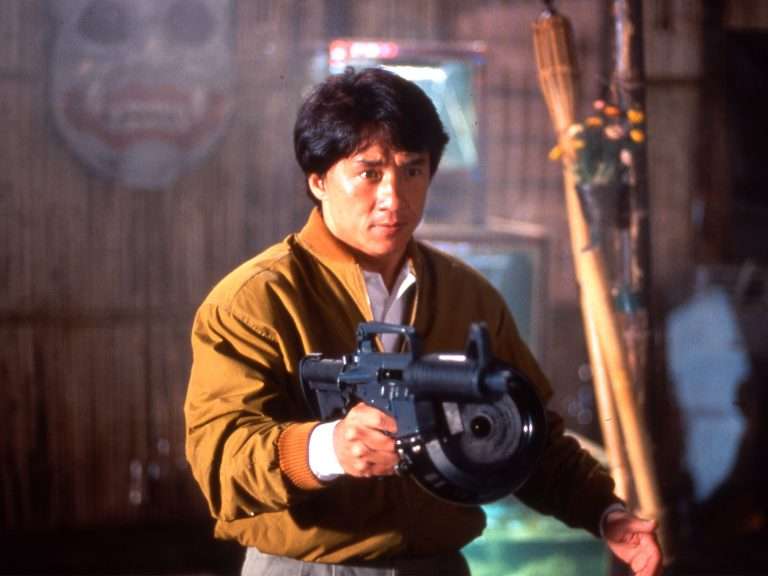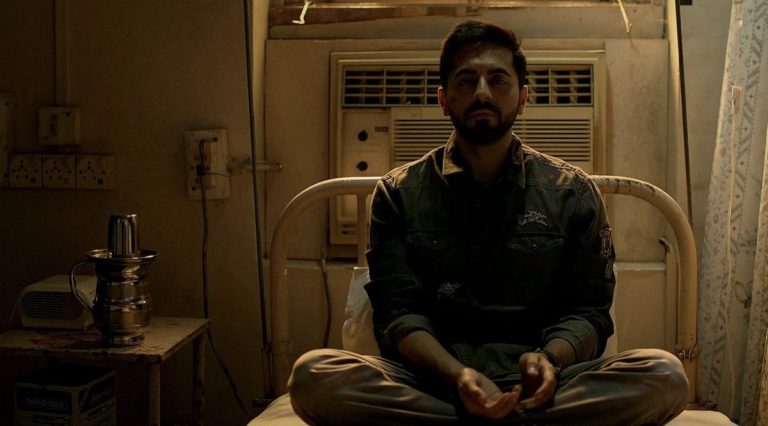We wouldn’t think paintings and cinema could have much in common because of their dimensional differences. But we can’t forget how the etymology of the term’ motion picture’ can be traced back to the Kinetoscope. Invented by Thomas Alva Edison in 1891, the Kinetoscope could take a series of photos on an endless band of film and create an illusion of motion with the help of a rapidly rotating shutter. This invention changed the world forever. The Kinetoscope walked so that the Cinématographe (revolutionary camera and projector built by the Lumière brothers, 1895) could run. We can safely say a picture or a painting was what gave birth to the cinema. Today we discuss 10 artworks that are excessively reminiscent of cinema:
1. Salvador Dali’s Persistence of Memory and Inception
Salvador was a great admirer of Sigmund Freud and was fascinated by his work on dream interpretation and tapping into the world of the human unconscious. This painting found much inspiration in similar themes of humankind’s life experiences, desires, and fears. This painting has four distinct elements: the landscape based on his home near the foothills of the Serra de Rodes with a stunted and lifeless olive tree across the calming water. The second element comprises the melting clocks. Dali laughed off the question of melting clocks saying that it was inspired by melting cheese. However, I believe there is more to it than what he said. Being a surrealist painter, the melting clocks were a significant reminder of the fact that nothing is constant. Time is nothing but a dreamlike place where reliability is hard to find. The third element is a surreal melting figure that is, perhaps, a representation of Dali himself in a dreamlike state. The last element is the congregation of ants at the back of the only facedown pocket watch in the entire composition. Analysts believe that ants are the creatures that arrive to collect any crumb of sustenance they can find, and sometimes they are the agents of destruction nurturing the dead and the decayed.
Nolan believed that Inception was more than science fiction. It was about finding catharsis. He said, “the catharsis found in a dream is as real as the catharsis found in a movie is as real as the catharsis found in life.” Cobb (Leonardo DiCaprio) is a master extractor. Through dreams, he can both withdraw and insert information that he deems fit to meet the success of the mission – a process called “inception.” Hired to enter the mind of a major CEO’s son and plant the idea to break up his father’s company, Cobb assembles a team of people to help carry out this task. While Freud was mostly associated with his work with the unconscious, Carl Jung, one of his followers worked extensively on the theory of archetypes and the subconscious at large.
Related to Paintings and Cinema: 10 Films Like Inception
The three main characters of this movie Cobb, Mal (Marion Cotillard), and Robert Fischer (Cillian Murphy) each have their own journey from Disunity to Unity. Fisher had a very tumultuous relationship with his father and the emptiness he felt due to the absence of a loving father became the precipice of bitterness. He decides to take away the very motivation of his father: his business empire. Mal is being kept alive by Cobb’s memories by entering into a dreamlike state again and again. She could never find fulfillment in her relationship with Cobb. She eventually turned aggressive towards him and took the ultimate revenge by ending her life. Cobb on the other hand is a husband in denial. He is separated from his kids and his wife and this very seclusion is killing him from the inside. He wants to keep dreaming because he is still together with his family, happily. Dali was no exception. The surreal nature of life made him long for a happy ending, that he may or may not have found.
2. Vincent Van Gogh’s The Starry Night and Dead Poets Society
Vincent van Gogh, in full Vincent Willem van Gogh was a post-impressionist painter. He was raised in the Netherlands and had a quiet, self-contained youth. He became extremely famous posthumously. He had a troubled mental state and had cut off the lower half of his left ear after a serious breakdown. He was hospitalized after this and later checked himself into a mental health asylum. He had recurrent manic and depressive episodes that likely translated onto his most famous work ‘The Starry Night’. At this stage, he was losing touch with reality and was grappling with sadness. He was stuck in this asylum with no other view than the garden outside his window. He wasn’t left with much inspiration and relied on painting from his memory. He muted the summery, saturated colors of the year before and replaced it with a calm, starry night with the same garden he remembered through his window. His brushwork was very expressive and broad and his sense of nature was very lyrical.
He shot himself one day riddled with loneliness and depression. However, he didn’t die immediately. When interrogated by the police, van Gogh refused to answer questions, saying, “What I have done is nobody else’s business. I am free to do what I like with my own body.” Starry Night creates a contrasting sense of life and death together with the luminous stars and the peaceful village underneath.
Related to Paintings and Cinema: 10 Films Like Dead Poets Society
The same can be said about the movie Dead Poets Society. The movie stars John Keating (Robin Williams) as a young teacher at his alma mater, a prestigious male prep school called Welton Academy in 1959. He comes in with a fresh perspective in a highly conservative school that makes his students try their best to seize the day or what Mr. Keating called ‘carpe diem’. In an attempt to bring back to life a poetry club called the Dead Poets Society, the little boys come together to form an extraordinary camaraderie.
This movie takes a tragic turn when the character called Neil commits suicide because of the way his father disapproved of his passion for acting and decided to put him in a military school. When the suicide is investigated, Mr. Keating is alleged to have abetted this suicide and he loses his job. This movie talked about a lot of mental health issues that we go through as children and adults. The Starry Night and The Dead Poets Society is an homage to a troubled mind that required nothing more than the bare minimum of compassion and kindness.
3. Yayoi Kusama’s Infinity Room and Everything Everywhere All At Once
Yayoi Kusama, a Japanese female artist who rose to fame in the 1960s was one of the most controversial art pioneers in a largely male-dominated industry. She described herself as an “obsessional artist”. She started painting as a child and the bulk of those paintings used extensive polka dots which became her trademark for the paintings and installations she made later on in her career. Kusama was one of the most eccentric artists of her time and these polka-dotted paintings were a result of the hallucinations she experienced throughout her life. She would often see dots in her hallucinations and she decided to turn one of her scariest, almost out-of-body experiences into art that would allow the spectators to get a glimpse of her subconscious. She described these hallucinations and intense anxiety as ‘dissolution and accumulation. Proliferation and fragmentation. The feeling of myself obliterating.’ She used the theme of repetition in her infinity room installation where thousands of tiny marks were obsessively repeated across large canvases and had mirrors attached along with them to create a boundless sense of infinity which was almost hypnotic.
This installation reminded me of the movie Everything Everywhere All at Once. This movie in my opinion also used the theme of repetition with the help of a multiverse where the characters could travel back and forth and acquire skills from one another. Evelyn (Michelle Yeoh), the protagonist of this film, is a mother who has to go on a secret mission to save her daughter. In doing so, she has to jump through these verses and take down Jobu Tupaki, the antagonist that looks very much like her daughter Joy (Stephanie Hsu). This film, just like Kusama’s Infinity Room, is an extension of Evelyn and Joy’s mental health which escalates throughout the movie. While Evelyn and Joy find ways of reconciliation at the end of the movie, it is hard to know if Kusama ever reached the point of true catharsis in her career as a pop artist.
4. Sandro Boticelli’s Birth of Venus and Titanic
Sandro Botticelli’s Birth of Venus is a revolutionary renaissance painting that initiated the element of nudity during the conservative artwork of the middle ages that reflected Christian values. This painting depicts the birth of a fully grown Venus, the Roman goddess of love, after her father was castrated and his genitals were thrown into the sea by his son, Saturn. The genitals mixed with sea foam thus gave birth to Venus. She was blown to the shore by the god of wind, Zephyrus when she was conceived and born in the sea. To the right of Venus is Aura, Zephyr’s wife also known as the nymph Chloris. Venus’s left portrays the goddess of Spring (one of the goddesses of the seasons collectively called Horae) who is waiting to wrap her in a red cloak. This painting started the conversation around female sexuality and love like never before.
Related to Paintings and Cinema: Every James Cameron Movie Ranked
The reason why Birth of Venus reminds me of Titanic is because of the overlapping paradigms of theatricality, drama, sexuality, and love. James Cameron was a revolutionary himself. He created a life-size cruise ship in the beach town of Rosarito, Mexico to capture the uncompromised grandiosity of the Titanic. He also created miniatures of the same cruise ship to film different scenes in the film. Cameron knew theatrics and VFX in ways no one had imagined. Cameron made a stunning film about the conflicts of class just like Boticelli’s painting did with the conflicts of religion. Venus’s nudity was a proclamation of a new age that wasn’t meant for the public eye. This painting was made to be hung in bedrooms, a space where intimacy can unravel away from the voyeurism of the public. Rose (Kate Winslet) and Jack (Leonardo Di Caprio) consummated their love in similar ways, away from condemnation and judgment. Birth of Venus is the birth of love itself and we need no reminder of how Jack protected Rose in the freezing water, believing in no separation than death itself.
5. Mona Hatoum’s Measure of Distance and Grave of Fireflies
Mona Hatoum is a contemporary Palestinian-British installation and video artist. She is known for the use of daily household objects in her art which is imbued with personal history and significance. Hatoum’s work frequently addresses politics and issues regarding gender and the body. She also challenged the two popular movements of surrealism and minimalism. In the 1980s she started making installations and sculptures that often had geometric patterns to portray the control within the society. Her family is Palestinian and they became exiles just like millions of other displaced Palestinians.
Measures of Distance 1988 is notably one of the most emotional videos constructed from images of Hatoum’s mother while she was taking a shower in their family home in Beirut. Her mother’s letters in Arabic veil the screen with an animated soundtrack of Hatoum and her mother’s conversation and clippings of those letters read out in between. The video was more than the emotional intimacy between a mother and a daughter, it also spoke of exile, displacement, and a tremendous sense of loss and separation caused by war.
Related to Paintings and Cinema: All Studio Ghibli Movies Ranked
Grave of Fireflies has a similar trajectory. Isao Takahata’s tragic film about the atomic bomb explosion in Japan caught us off-guard. We weren’t prepared for the story of a brother and his untiring attempt to save his little sister. This movie is about the value of life even in the face of irreversible tragedy. Even though it has earned the reputation of one of the darkest Ghibli movies ever made, this movie is a reminder of how the ‘firefly’ represents the deadly fire bombs as well as a symbol of hope and perseverance. Seita Yokokawa (brother) and Setsuko Yokokawa (sister) share heartbreaking experiences of losing their mother to the bombing, being displaced from their home, and in the end, prolonged and endless starvation. Both the video and the movie talk about the dreadful effects of war and invokes a humanistic appeal toward ending this kind of tragedy.
6. Frida Kahlo’s The Two Fridas and Synecdoche, New York
Frida was a Mexican self-portraitist and an early 20th-century feminist icon. She had a very tragic life. She got polio at the age of 6 which crippled her leg. She then met with an accident when she was 18 years old and was left bedridden for a year. That’s when her parents decided to arrange a canvas small enough for her to maneuver in a bedridden condition. She then had to undergo an amputation because her crippled leg was affected by gangrene in 1954. She had to wear metal corsets to stabilize her spine whenever she walked or made any movement at all. Her painting Two Fridas is about the struggle of an individual to find her own identity. On the left, she wears a European dress and on the right, she wears a traditional dress that is symbolic of her heritage. Her mother was Mexican and her father was German which is a very big reason why she felt a constant clash of cultures.
This portrait has many underlying elements that took over her life in a rather unfortunate way. It is understood that this painting can also be connected to her relationship with her husband, Diego Rivera, who appreciated her Mexican mannerisms and fashion more than her European heritage. She had a very toxic relationship with her husband who was a serial cheater and always took advantage of their age difference. She had divorced him but got remarried a year later. They both had relationships outside the marriage and there were a lot of emotional conflicts between them. There is also a lot of exposition about the pain she suffered due to her diseased life.
There are two exposed hearts in the painting; the left one has an artery cut by medical pincers and is bleeding profusely while the right one is still intact. I felt like this metaphor fits the movie Synecdoche, New York too because as twisted as this story is, Charlie Kaufman (writer/director) explores a brutal identity crisis through solipsism. Solipsism is a belief that one’s perception is the only acceptable reality while harmfully dismissing ‘the Other’. Caden Cotard (Philip Seymour Hoffman) plays the character of an overachieving theater artist who is striving endlessly to create his magnum opus. He puts all of his finances into making this one play which is a version of his own life with actors playing different phases of himself and his loved ones. His overweening fear of his health and his compulsive need to perfect this play is so all-encompassing that all the other people in his life are like the characters of the play, who come and go.
He hardly notices his wife who is seen with a persistent cough and ends up with a critical disease. Kaufman is a very troubled man. He does not hold the hands of the spectators through this unsettling drama. He is known best for movies like Adaptation where the protagonist is a fictional version of himself. Both these movies don’t end on a happy note. There are no epiphanies or any drastic character development. Both of them are struggling artists who are frustrated with the lack of acknowledgment in their lives. Synecdoche, New York ends on a rather cynical note when Millicent (Diane Wiest) tells an old and hunched Caden, “You realize you are not special, you’ve struggled into existence and are now slipping silently out of it. This is everyone’s experience. Every single one. The specifics hardly matter; everyone is everyone.” His magnum opus didn’t happen and he slowly withered away into oblivion.
7. Amrita Sher-Gil’s Self Portrait and Gangubai Kathiawadi
Known as the Frida Kahlo of India, Amrita Sher-Gil was born and raised in Budapest, Hungary. She had a Punjabi father and a Hungarian-Jewish mother. Her early paintings had a huge western influence as she spent most of her time in Paris. In the 1930s, her work started getting recognition. Her work involved various self-portraits often set in the backdrop of her personal life; with friends and other loved ones. She returned to India in 1934 and rediscovered the grandeur of traditional art such as the cave paintings at Ajanta, Mughal, and Pahari art. She went to visit Southern India a couple of years later to find inspiration in the daily life of those people. Her work based in Southern India was very distinct from the work she had done in Europe. Extremely noticeable changes were found in her later work that had a completely different color palette and a sense of empathy that she felt for the people who were barely making ends meet.
Her self-portrait is very similar to Sanjay Leela Bhansali’s Gangubai Kathiawadi. When I think about Gangubai and Amrita Sher-Gil, the first thing that captures my attention is their exceptional sense of self-worth. Amrita traveled to India all by herself to explore her artistic capabilities despite her father telling her that she has no future there. Nobody believed Gangubai, a former prostitute could become the president of Kamathipura either. We all know how both of these stories end. Amrita created some of her best works here and well Gangubai walked the same streets of Kamathipura that had ripped her off of her childhood, but now as a politician. Both of these women had a very strong attachment to India’s traditional attire: the saree. Amrita’s attachment stemmed from her hybrid and diasporic identity. While she loved her home in Hungary, she longed for a sense of belonging in India. Gangubai on the other hand adorned herself with white sarees because white was the color of politicians and politicians had social capital. The only way she could change the lives of sex workers was through this social capital. Even though Amrita’s career was short-lived, she left a compelling body of work. She worked on the themes of realism and post-impressionism by depicting the life of the marginalized which was antithetical to her own. Both of these women rose to fame and recognition at a very young age. They truly proved that self-discovery is a scary journey. It requires you to be alone. But it is so worth making.
8. Two Lovers by René Magritte and The Scenes From A Marriage (TV Series)
The lack of fulfillment and defeated desires are common themes in René Magritte’s work. This is a very famous painting that shows how an intimate embrace between two lovers is prevented by the use of fabric. The fact that their faces are fully wrapped shows how an act of passion is transitioning into one of isolation and frustration. Critics have also said that “this work is a depiction of the inability to fully unveil the true nature of even our most intimate companions.” One common motif found in his work is enshrouded faces. René had declined the correlation between his paintings and the fact that when he was 14, his mother had committed suicide and had to be fished out of the water while her nightgown wrapped around her face. This sounds like major speculation but cannot be ignored altogether. He mentioned that he always liked the element of mystery in his work and these faceless characters provided him with that artistic desire.
Two Lovers reminded me of the tv series Scenes From A Marriage starring Jessica Chastain (Mira) and Oscar Isaac (Jonathan). This is an adaptation of the Swedish drama written and directed by Ingmar Bergman in 1973. In this series, Mira and Jonathan’s relationship has hit a point of no return. Mira has started to feel suffocated in this relationship and wants to part ways. The best part about this series was the fact that Jonathon didn’t try to save himself over the relationship. He let Mira fall apart and even helped her pack her suitcase when she was frantically trying to leave. I have seen very few shows where the partners have a non-mutual break-up and even then they support the other half of their relationship to get back on their feet. Jonathan in a way can’t fall apart because Mira already is. Sometimes love can turn into a crisis overnight and that’s what happened to Jonathan.
This show has a very voyeuristic nature. We as an audience just sit back and witness the many layers that stood together the test of time and love. I believe as a society we are looking at the union of two people completely wrong. We put the institution of marriage on such a high pedestal as if that is the only milestone of adulthood and the ideal starting point of procreation. This drama reminds us that marriage is not a declaration of unbridled love and undying devotion for a lifetime. The one incident that triggers the rest of the show is Mira’s infidelity. Both of them are on the precipice of divorce and they can feel the anxiety of separation creeping in. The biggest development we see in Jonathan’s character is at the very end. He tells Mira that he wants to absolve himself from the pressure of being moral all the time. The painting and the drama are a lot alike. But if I had to speak as a spectator, I would say this show is an extension of the painting and nothing else.
9. Caspar Friedrich’s Wanderer Above The Sea Fog and Portrait of A Lady On Fire
Some believe Wanderer above the sea fog is a self-portrait because the character has the same fiery red hair as Caspar. The figure is seen standing in deep contemplation looking over the endless horizon of the sea and wondering about the bounties of the unforeseeable future. We see the character’s back not because Friedrich was trying to shut us out but to enable us to see the world through his perspective. This technique is called the Ruckenfigur technique in which he paints the figure with his back to the viewer. He didn’t usually include people in his paintings but it was rumored that he married at the time when he painted wanderer above the sea frog and he discovered a newfound appreciation for humankind. He followed the ideals of Romanticism and played around with the themes of self-glorification, man’s role in nature, divinity, and subjectivity.
This painting comes very close to the movie Portrait of A Lady On Fire. Céline Sciamma, the French writer/director of the movie mentioned in an interview with The Independent, “I wanted to question what a happy ending is. We have the romantic-comedy philosophy – a frozen image of two people being together – and we also have the tragic ending. And I wanted neither. Why do we believe that eternal possession of somebody means a happy ending? Love educates us about art. Art consoles us from lost love. Our great loves are a condition of our future love. The film is the memory of a love story; it’s sad but also full of hope.”
Related to Paintings and Cinema: All Celine Sciamma Movies Ranked
Set in the 18th century, Marianne (Merlant) is a young artist who travels to Northern France to paint a portrait of Héloïse (Haenel), a young woman who is set to marry. This painting is supposed to be a gift from her mother for her marriage. Héloïse refuses to sit for the portrait because she loathes the thought of getting married. Hence, her mother (Valeria Golino) commissions Marianne to be her companion and study Héloïse enough to paint her by memory. In this journey, they both fall for each other. Given the time period, it only made sense for them to part ways. Even then the movie ends on a very hopeful note. Héloïse’s reading of the ‘Orpheus and Eurydice myth’ by firelight to Marianne acts as a powerful element of foreshadowing. Orpheus, who travels to the underworld to retrieve Eurydice back from the dead, is told to not look back at her. However, he breaks this rule, sending her back to the depths until he can join her again. Marianne believes they share the same fate. She, just like Orpheus chooses the memory of Héloïse and in doing so immortalizes her forever.
10. Hannah Höch’s The Beautiful Girl and The Wolf of Wall Street
Known best for her incisively political collage and photomontage works, Höch rearranged clippings from mass media to critique the German government at the time. A pioneer of Dadaism, she preferred metaphoric imagery to the more direct, text-based confrontational approach of her peers. She rejected the German government, but often focused extensively on gender issues, and is recognized for her revolutionary works such as Das schöne Mädchen (The Beautiful Girl), (1920), an attempt to critique industrial advertising and the false beauty standards perpetuated by it.
I found a similar trope in Martin Scorsese’s The Wolf of Wall Street. Laura Mulvey ( feminist film theorist from Britain, best known for her essay on Visual Pleasure and Narrative Cinema) gave The Male Gaze theory which spoke about the objectification of women in the media. She further stated that “the gender power asymmetry is a controlling force in cinema and constructed for the pleasure of the male viewer, which is deeply rooted in patriarchal ideologies and discourses.”
Related to Paintings and Cinema: 10 Best Martin Scorsese Movies
This movie fails to say anything interesting about the women who cross paths with Jordan (Leonardo Di Caprio). Scorsese probably was making an attempt to portray how marginalized women were in the trading world of Wall Street in the 80s and the 90s. However, he went a lot overboard and completely defeated the purpose he was in pursuit of. The breasts, stilettos, and interchangeable Barbie doll-like female characters were nothing more than props in the movie. With their debauched antics and naked-shaven bodies, they were used for titillation and seduction. There was a lot of feminist outrage surrounding this movie, just like the artwork of Höch.


